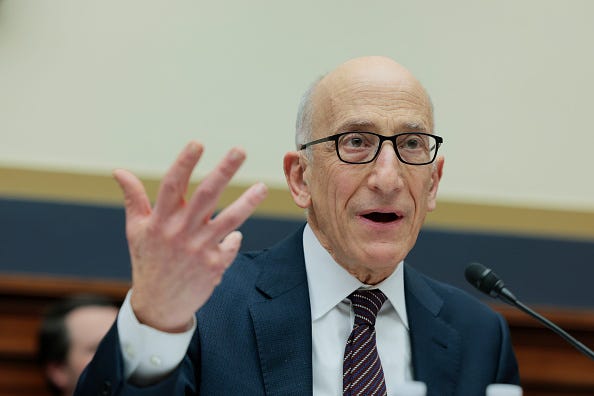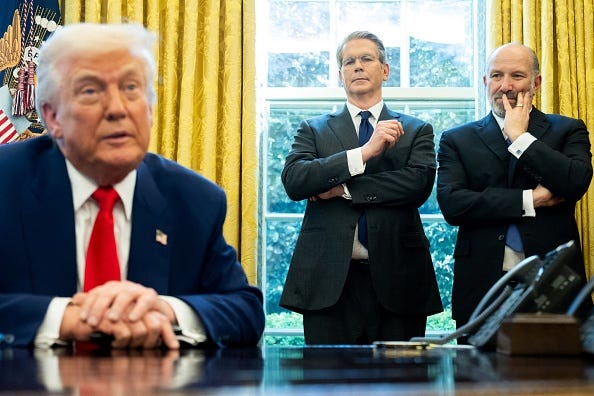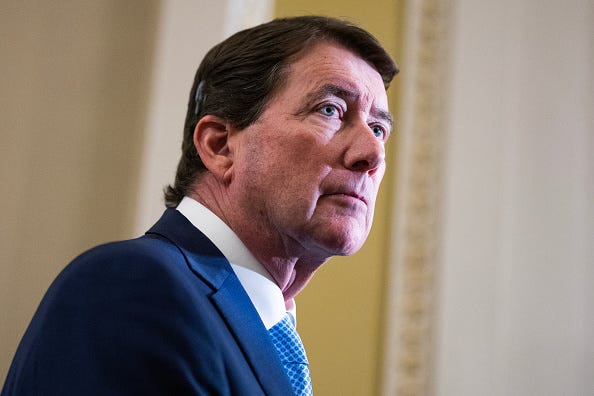Talking Crypto Regulation; Trump Juices Fannie, Freddie Privatization Fight; Stablecoin Bill Jockeying
Capitol Account: Free Weekly Edition
Sponsored by MFA, the trade association for the global alternative asset management industry.
News abounded in financial regulation this week. Chairman Paul Atkins, on the job for several weeks now, began to flesh out his plans for the SEC. High on his list: allowing retail investors to tap into hedge and private equity funds. Meanwhile, the agency’s acting enforcement chief came out and defended his staff, who’ve been under attack by the crypto industry — and Donald Trump. There’s a lot less going on at the CFTC, where the commissioners continued to bolt for the exits.
The debate about privatizing Fannie Mae and Freddie Mac, which play a key role in the mortgage markets, has been pretty quiet this year. But that changed quickly, thanks to a presidential tweet that prompted a whirlwind of questions and speculation. And as the Senate comes closer than ever to passing a new oversight framework for stablecoins, we took a look at several sticky issues that have yet to be fully resolved. In our Friday interview, a former CFTC chairman offered some ideas for fixing the bill.
Thanks for reading our digest of articles published this week. For much more coverage, click the button below to become a paid subscriber.
Friday Q and A: The Senate finally seems to be on the cusp of passing landmark legislation setting out oversight for stablecoins. But as lawmakers continue to negotiate the details, tricky questions keep popping up on issues big (curbing illicit finance) and small (defining a payment token).
This week we sat down with Timothy Massad, who has been a key advisor to Democrats on crypto policy, to get his thoughts on the endgame. A former chairman of the CFTC in the Obama administration, he was one of the first regulators to grapple with bitcoin a decade ago. He sees the stablecoin measure as less than perfect – but also fixable. And he has some strong views on digital assets oversight more broadly, including whether Congress is taking the right approach on attacking crypto market structure, its next major legislative effort.
Read on to learn Massad’s thoughts on how the stablecoin bill can be improved, the power of the crypto lobby and whether the SEC and CFTC should be merged. What follows is our (lightly edited and condensed) conversation.
Capitol Account: What’s your background?
Timothy Massad: I was a lawyer in private practice for 25 years. I did financial transactions, M&A, securities, derivatives. I was based primarily in New York, but I spent five years in Hong Kong and a couple years in London as well.
CA: How did you come to Washington?
TM: The financial crisis happened, and I raised my hand. I first helped Elizabeth Warren, who had been a professor at Harvard Law when she was appointed to run the Congressional Oversight Panel. I was the first lawyer that they brought on…I then joined Treasury as the chief counsel for the Troubled Asset Relief Program and [later] became the assistant secretary in charge of it.
CA: You’re also known in the crypto world from your time as CFTC chairman, when the agency determined bitcoin was a commodity.
TM: We did that in late 2014, and it was subsequently upheld by the courts. We took the first enforcement actions, and also approved bitcoin swaps. We were early in the game, the first regulator I think almost anywhere to do anything.
CA: How did you become involved in the negotiations over the GENIUS Act?
TM: I've wanted us for years to create a regulatory framework, both to address the risk and enable the private sector to see the opportunity for stablecoins. I think they are the most important application of blockchain and tokenization technologies to date. While they are used primarily for crypto trading today, they could become an important general means of payment.
CA: It’s a bit of a moving target, but what do you think of the latest version of the bill?
TM: I think it has a number of good features, [including] prudential requirements…It still has some significant weaknesses that will undermine the overall framework if they're not fixed.
CA: What are they and can they be addressed?
TM: I think they can be easily fixed. To highlight the main ones: There are some glitches in the definition of stablecoins; the application of the law to foreign issuers needs to be strengthened; and the protections against the use of stablecoins for illicit finance need to be strengthened.
CA: The CFTC is much smaller than the SEC. Does it need more funding to play a leading role in crypto oversight?
TM: They're going to need significantly more resources. I always told the former chair [Rostin] Behnam when he was [asking for more] authority, `Be careful what you wish for.’ Because if you don't get the resources, it's going to be impossible.
CA: The digital assets industry’s power has grown a lot in Washington since Trump was elected. How is that influencing these legislative debates?
TM: They've obviously spent a huge amount of money in the last federal election, and that's having a big effect. That concerns me a lot. I worry that we won't get laws that provide sufficient investor protection because of their lobbying.
CA: Trump has gotten a lot of criticism from Democrats over his crypto ties. Are with the industry his business dealings appropriate?
TM: We've never had a president who has so brazenly engaged in businesses that provide personal enrichment, particularly in an area where public policy is so important right now. We're trying to create a regulatory framework for this. I think it's very unfortunate that he's doing this. It makes one wonder: Is the priority promoting innovation or is the priority promoting personal enrichment?…(Friday)
Click here to subscribe and read the rest of the interview.
Thanks for reading. Follow us on X @CapitolAccount and on LinkedIn by clicking here. We’re always looking for stories, so if you have any suggestions on what we should cover (or comments about Capitol Account), shoot us a note. Rob can be reached at: rschmidt@capitolaccountdc.com and Ryan at rtracy@capitolaccountdc.com. If somebody forwarded this to you and you’d like to subscribe, click on the button below. Please email for information on our special rates for government employees, academics and groups: subscriptions@capitolaccountdc.com.
Kick-Start: Scott Bessent and Bill Pulte have spent the past few months tip-toeing around one of the most fraught issues in housing policy: When and how to release Fannie Mae and Freddie Mac from conservatorship. But then the president weighed in.
“I am giving very serious consideration” to taking the companies public, Trump proclaimed on social media, adding that he would be speaking with the Treasury chief, FHFA director and Commerce Secretary Howard Lutnick and “making a decision in the near future.”
The missive landed with a bang – an IPO would be the largest in history. In the financial regulatory world, where the debate over wresting the firms from government control has simmered for more than a decade, the seemingly out-of-the-blue pronouncement also touched off a whirlwind of questions and speculation.
For one thing, what prompted the post? Was Trump, who has a habit of spouting half-baked ideas, serious? Can it actually be done without affecting mortgage interest rates, which the president wants to keep down? Why is Lutnick involved? What about Congress?
Not surprisingly, opinions and answers abound. But sources on all sides see one thing as clear: Trump has kick-started a potential battle royale. Privatizing the GSEs still may not happen, but the odds have gone up considerably. Some are hopeful the effort can come to fruition as soon as next year. Others aren’t yet convinced, noting that it will take a combination of political will and lots of hard work. As one longtime analyst who has been bearish on ending the conservatorship explains, “Now I can’t be dismissive, but I can be skeptical.”
What follows is a look at the current debate and what may lie ahead.
Expectations: Few are surprised by Trump’s desire to take the companies public – eventually. Springing Fannie and Freddie has long been a GOP goal, and it’s something that the Treasury and FHFA tried to accomplish during Trump’s prior term. In 2021, the then-former president underscored in a letter to Sen. Rand Paul that with more time in office, “my administration would have…sold the government’s common stock in these companies at a huge profit and fully privatized” them.
Still, the urgency of the president’s post jolted many observers who have been expecting a slow and deliberative process. That was, in part, based on reading between the lines of cautious public comments by administration officials. “If and when something were to happen, we would be laser-focused on making sure it would be extremely thoughtful,” Pulte said in a recent interview.
Details: Trump also left a lot to fill in about the administration’s ultimate plans, including the level of ongoing government involvement and support for the companies’ bonds. That’s the key to answering a primary political consideration about any proposal to take Fannie and Freddie public: the impact on mortgage rates.
Team Trump, of course, has hammered home the notion that the president is bringing costs down. “Inflation has been out of control,” Pulte said in another of his many recent public appearances. “We are working every day to reverse it.”
Yet eliminating Fannie and Freddie’s reliance on Uncle Sam could well push up rates. Michael Bright, CEO of the Structured Finance Association, notes that without a government backstop, credit rating agencies might have to downgrade Fannie and Freddie while investors in mortgage-backed securities would have to reassess the credit risk they are taking on. “You can’t just completely get the government out unless you are willing to jack up rates,” Bright says.
Others see the fear as overstated. The two firms have always had an implicit government backing, they point out, and that wouldn’t change.
Motives: There are also plenty of suspicions about what, exactly, Trump hopes to accomplish. While only the president knows for sure why he decided to speak out on Wednesday evening, it’s worth considering the timing. Some argue that it's no accident that the statement was released in the middle of the fight over his “big, beautiful bill,” a measure that the Congressional Budget Office estimated this week will add more than $3 trillion to the deficit.
At least so far, Republicans on Capitol Hill aren’t trying to use the funds from a Fannie and Freddie IPO to offset spending and tax cuts. But that also could change. And either way, talking about the plan could give Trump a way to show that he is bringing in revenue. “This is bright-shiny object bullshit,” contends one Democrat. Trump, for his part, stressed in his post that “Fannie Mae and Freddie Mac are doing very well, throwing off a lot of CASH.”…(Thursday)
Click here to subscribe and see the rest of the story.
Thanks for reading. Follow us on X @CapitolAccount and on LinkedIn by clicking here. We’re always looking for stories, so if you have any suggestions on what we should cover (or comments about Capitol Account), shoot us a note. Rob can be reached at: rschmidt@capitolaccountdc.com and Ryan at rtracy@capitolaccountdc.com. If somebody forwarded this to you and you’d like to subscribe, click on the button below. Please email for information on our special rates for government employees, academics and groups: subscriptions@capitolaccountdc.com.
Heating Up: With the Senate’s stablecoin bill clearing a key hurdle this week, lawmakers are closer than ever to establishing a new regulatory regime for the tokens. But the lobbying is far from over – and a diverse group of banks, merchants, crypto companies, tech firms and state regulators are battling down to the wire to shape the final outcome.
The fight doesn’t revolve around the legislation’s core provisions, which are said to be pretty locked down. States and the OCC will be able to license “payment stablecoins” and subject them to capital, liquidity and anti-money laundering requirements. Nevertheless, there has been a whole lot of jockeying in recent weeks on a host of other issues, such as whether the tokens will pay interest, what companies are allowed to offer them and how the oversight applies to foreign issuers. Bill Hagerty, who is spearheading the GENIUS Act, filed an amendment Wednesday addressing some of the concerns.
Even more changes could be coming as the bill is debated on the Senate floor. What follows is a look at the state of play in some key areas still under discussion.
Taking a swipe: Roger Marshall has kicked up a hornet’s nest by seeking to add his and Richard Durbin’s Credit Card Competition Act to the stablecoin package. The hotly debated measure requires large banks to employ at least two payment networks (including one that isn’t Visa or Mastercard) for processing their credit cards.
The gambit may get nixed because it could upset the delicate compromise that has so far carried the stablecoin bill – and a vote on the credit card restrictions would put lawmakers in an awkward spot of choosing sides between two powerful industries. But retail and financial advocates aren’t waiting to find out. The National Grocers Association highlighted the issue as its members canvassed Capitol Hill during a (well-timed) fly-in this week. On the other side, the Electronic Payments Coalition has been running ads in D.C. newsletters. The American Bankers Association and nine other trade groups wrote to Senate leaders calling the attempt “a poison pill amendment that…would harm consumers, small businesses and financial institutions.”
Not to be left out, Josh Hawley is also seeking to add a 10 percent credit card interest rate cap. That could present another conundrum, given that banks vociferously oppose the measure but Trump supported it on the campaign trail. Not surprisingly, there’s a growing movement to push Senate leaders to quash both amendments.
Eating banks’ lunch: One of the biggest misgivings in the banking industry, especially among small lenders, has been the potential for stablecoins to replace traditional deposits. The tokens’ value is pegged to a currency like the dollar, so it’s possible they could play a similar role of storing cash but in digital form…(Wednesday)
Click here to subscribe and read the rest of the article.







